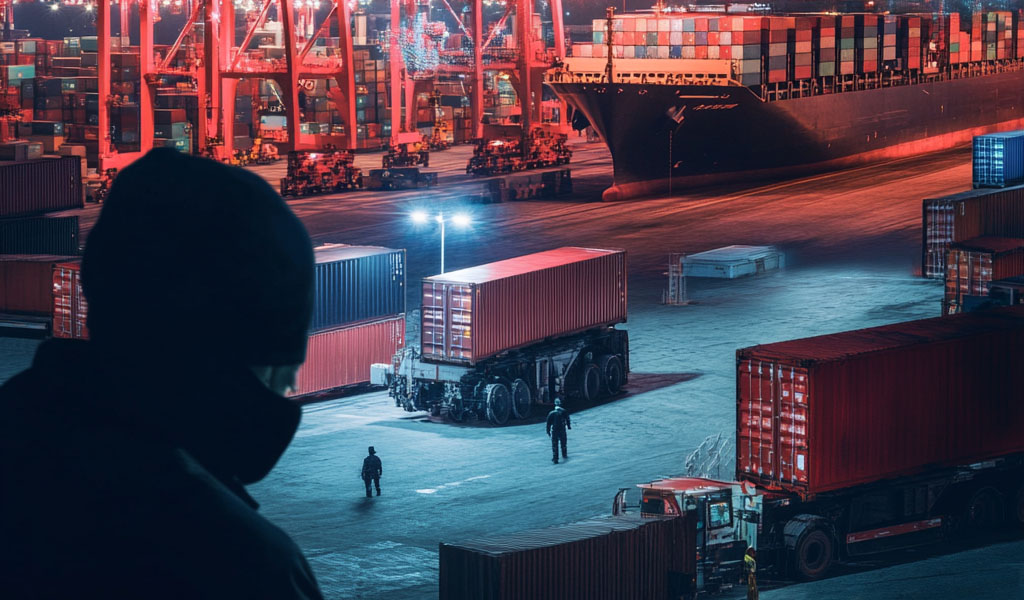
Supply Chain Nightmare: Tariffs, Strikes & Chaos – Are You Prepared?
It was just after midnight when my phone buzzed with an urgent message. A logistics director in Detroit at one of the world’s largest automakers, was staring at a disaster in real-time.
Thousands of critical automotive parts—engine components, transmissions, and electrical systems—had vanished from their supply chain. Containers filled with high-value inventory were sitting in limbo somewhere between their suppliers and assembly plants. With no visibility into their exact locations, production delays were imminent, threatening millions in lost revenue and downtime.
But this wasn’t the first time we had seen this.
At GPX Intelligence, we specialize in bringing visibility to supply chain blind spots, and in our short partnership with the auto maker, we had already saved them over $26 million by recovering lost parts and containers from over 246,000 containers. Using our real-time tracking platform, we pulled up the data instantly—pinpointing the exact locations of 1,200 containers that had been misplaced, delayed, or assumed lost.
Within minutes, we identified where the missing shipments had stalled, flagged the ones stuck in the wrong hubs, and redirected the necessary parts to keep their production lines running. What would have been a multi-million dollar supply chain disaster was averted—because they had the real-time intelligence to act fast.
Supply chain disruptions like this happen every day, from geopolitical tensions and tariffs to labor strikes and theft. Without real-time visibility, businesses are gambling with their supply chains. That’s why in today’s high-risk global economy, tracking, monitoring, and optimizing every step of your logistics isn’t just an advantage—it’s a necessity.
Trump’s Tariffs: How They Disrupt Supply Chains and Make Visibility Essential
In a recent article titled “Inside the Chaotic Run-Up to Trump’s Tariff U-Turn,” Gavin Bade of The Wall Street Journal reported, “The past 48 hours of tariff policies have stunned markets and boardrooms across the world.”
This volatility underscores the critical need for robust supply chain visibility. Trade wars, evolving tariffs, and geopolitical tensions can disrupt established routes and operations overnight. Without real-time insights, companies risk delays, increased costs, and operational inefficiencies. Implementing advanced tracking and monitoring systems is essential to navigate these uncertainties and maintain a competitive edge.
Moreover, the rapid imposition and subsequent reversal of tariffs have left businesses scrambling to adjust. As noted by The Wall Street Journal, “The rapid changes in tariffs imposed by President Trump on Canada, Mexico, and China have significantly increased the importance of customs brokers in global supply chains.”
This highlights the necessity for companies to have agile and transparent supply chains that can adapt swiftly to policy shifts. By leveraging real-time data and analytics, businesses can make informed decisions, mitigate risks, and ensure continuity in their operations amidst the ever-changing trade landscape.
Supply chains aren’t just moving goods—they’re navigating a minefield. For over a decade, GPX Intelligence has been at the forefront of solving these challenges, providing cutting-edge location intelligence and asset tracking solutions to industries ranging from automotive and manufacturing to logistics, construction, and energy.
We work with some of the biggest global brands, including Stellantis, Airbus, Toyota, and SpaceX, helping them recover millions in lost assets, mitigate supply chain risks, and optimize logistics in real-time.
Trade wars, AI-driven automation, and IoT-powered logistics are reshaping the landscape, but many companies are still operating with blind spots. Tariffs shift overnight, routes get disrupted, and theft thrives in the chaos. Without real-time visibility, every shipment is a gamble.
- No Real-Time Location Tracking – If you can’t see it, you can’t secure it. Tariff-driven reroutes and global instability demand precise GPS tracking. GPX delivers full shipment visibility, so you’re never in the dark.
- Cargo Theft and Loss – Economic uncertainty fuels organized theft. Stolen goods mean lost revenue, rising insurance costs, and customer distrust. GPX’s geofencing and tamper alerts turn every asset into a monitored fortress.
- Inefficient Routing and Delays – AI is optimizing supply chains, but without real-time data, outdated routes drain resources. GPX’s smart optimization adjusts for tariffs, weather, and congestion, keeping shipments on track.
- Unreliable ETAs and Delivery Delays – Predictability is power. Shifting regulations and supply chain volatility make ETAs unreliable. GPX uses predictive analytics to keep customers informed and operations smooth.
In a dramatic policy shift on April 9, 2025, President Donald Trump announced a 90-day suspension of tariffs exceeding 10% on dozens of U.S. trade partners, while doubling down on China by raising tariffs on its imports to a staggering 125%. The move, framed as a strategic reset rather than a retreat, sparked the most significant market rally since the early pandemic era, with the S&P 500 and global indices surging in response. The administration’s message was clear: “Do not retaliate and you will be rewarded.” While this temporary easing offers relief for many, the continued 10% baseline tariff and the volatile nature of U.S. trade policy are compounding uncertainty for global businesses. Analysts warn the abrupt shifts could strain supply chains and escalate corporate risk. In this high-stakes landscape, real-time visibility and agile response mechanisms are no longer optional—they’re critical to survival.
Consider the numbers:
- China: The U.S. imported $536.3 billion worth of goods from China in 2022, representing 16.5% of total imports.
- Mexico: Imports from Mexico reached $454.8 billion (14.2% of total imports).
- Canada: Imports stood at $436.6 billion (13.7% of total imports).
Fast forward to November 2024, and monthly imports from China were still around $36.08 billion, with annual totals between $400-$500 billion. Mexico and Canada remained the top trading partners, with imports exceeding $480 billion and $350 billion, respectively.
How Tariffs Are Increasing Supply Chain Costs & Disruptions
For businesses dependent on raw materials, electronics, and automotive components from these countries, tariffs are creating higher operational costs, supply chain bottlenecks, and production delays. Many companies now face difficult choices:
- Relocate production facilities to avoid tariffs.
- Seek alternative suppliers in regions like Southeast Asia or Latin America.
- Absorb higher costs or pass them to consumers, leading to inflation risks.
- Optimize logistics by improving supply chain visibility to mitigate tariff-related disruptions.
As supply chains grow more complex and unpredictable, real-time supply chain visibility is no longer a luxury—it’s a necessity. Businesses need AI-driven predictive analytics, IoT sensors, and automated tracking solutions to navigate these challenges effectively.
What Is Supply Chain Visibility and Why It Matters
Supply chain visibility refers to a company’s ability to track, monitor, and analyze its entire supply chain in real time—from raw material sourcing to final delivery. In an era where AI, IIoT, and automation are revolutionizing supply chains, visibility enables businesses to improve efficiency, mitigate risks, and adapt to disruptions with agility.
Defining Supply Chain Visibility in Today’s Digital Era
Supply chain visibility goes beyond just tracking shipments. It involves:
End-to-end monitoring of inventory, shipments, and logistics.
AI-powered predictive analytics to anticipate disruptions before they occur.
Real-time data sharing across suppliers, manufacturers, and logistics providers.
Automated alerts for delays, theft, temperature fluctuations, and compliance violations.
With IoT and IIoT devices, businesses can now track individual shipments, monitor environmental conditions (temperature, humidity, shocks), and receive instant alerts if something goes wrong. This level of intelligence ensures better decision-making and faster responses to supply chain risks.
The Importance of Supply Chain Visibility for Success
Supply chain visibility directly impacts costs, efficiency, and customer satisfaction for companies. Industries like automotive, manufacturing, pharmaceuticals, and e-commerce face constant pressure to optimize supply chains while dealing with increasing complexities.
Why Businesses Need Better Visibility
- Reduce Lead Times – AI-powered tracking tools help streamline procurement and delivery, ensuring suppliers and manufacturers stay aligned.
- Enhance Supplier Collaboration – With real-time data, suppliers, transporters, and warehouse teams can coordinate efficiently, avoiding costly miscommunication.
- Boost Customer Trust – Businesses that provide accurate ETAs and proactive updates retain customers better.
- Lower Operating Costs – By optimizing routes, reducing idle time, and preventing theft, businesses save millions in lost inventory and delays.
With rising global trade uncertainties, businesses that fail to leverage AI-driven supply chain visibility tools will struggle to maintain operational efficiency in 2025 and beyond.
Global Disruptions Underscoring the Need for Supply Chain Visibility
Recent events have exposed vulnerabilities in global supply chains, making real-time visibility more critical than ever.
- COVID-19 Resurgence (2024): While the worst of the pandemic is behind us, lingering supply chain disruptions persist. Over 776.8 million confirmed cases and 7 million deaths globally have contributed to reduced production capacity, logistics delays, and ongoing workforce shortages across industries.
- 2024 U.S. Port Strikes: The East Coast port strikes threatened to paralyze trade, with an estimated $5 billion in daily economic losses. Industries like automotive manufacturing, which rely on ports for $37.8 billion in vehicle imports annually, faced severe risks of plant shutdowns and inventory shortages.
- Trump’s Tariffs & Trade Policy Shifts: The U.S. has imposed 10% tariffs on Chinese imports and threatened higher rates on Mexican and Canadian goods. Though some tariffs were temporarily postponed, the uncertainty alone raises costs, disrupts supply chains, and forces businesses to rethink their sourcing strategies.
- Weather-Related Disruptions: Hurricanes, flooding, and extreme winter storms continue to wreak havoc on logistics networks. Infrastructure damage, shipping delays, and supply shortages have made real-time route optimization, AI forecasting, and IIoT-powered tracking critical for resilience.
These economic, labor, and climate-driven disruptions make it clear: Supply chain visibility is no longer optional—it’s a necessity. By leveraging real-time tracking, predictive analytics, and automated risk mitigation, businesses can anticipate challenges, minimize losses, and maintain operational efficiency despite external shocks.
Key Benefits of Real-Time Supply Chain Visibility for Businesses
Real-time supply chain visibility brings tangible benefits, from optimizing daily operations to mitigating major risks. Let’s break down how:
1. Faster, More Accurate Decision-Making with AI & Automation
Advanced analytics predict potential delays and disruptions, allowing proactive management. Automated inventory tracking ensures optimal stock levels, preventing both shortages and excesses. Real-time dashboards offer comprehensive insights, facilitating informed decision-making.
2. Reduced Risk of Cargo Theft & Loss
Continuous GPS monitoring, coupled with geofencing and tamper alerts, protects valuable shipments. Industrial Internet of Things (IIoT) sensors detect unauthorized movements, enhancing security during transit. Immediate tracking capabilities enable swift responses, increasing the likelihood of cargo recovery.
3. Optimized Transportation & Delivery Routes
GPS-enabled route optimization minimizes fuel consumption and reduces delivery times. AI-driven scheduling adapts to challenges like severe weather conditions and traffic congestion. Accurate Estimated Time of Arrivals (ETAs) improve customer satisfaction and decrease the rate of failed deliveries.
4. Cost Reduction Through Efficient Inventory & Logistics Management
Predictive analytics help in maintaining lean inventory, reducing holding costs. Just-in-time (JIT) strategies enhance cash flow by aligning inventory with demand. Automation in warehousing streamlines fulfillment processes, leading to significant cost savings.
5. Enhanced Compliance & Supply Chain Security
Technologies like blockchain provide secure, tamper-proof documentation, ensuring compliance. IIoT sensors monitor environmental conditions, crucial for sensitive goods such as pharmaceuticals and perishable foods. Adherence to customs and regulatory requirements prevents fines and avoids shipment delays.

Common Challenges in Supply Chain Management
Running a smooth supply chain is like juggling a bunch of balls while riding a unicycle – it takes skill, coordination, and the right tools. But even the best jugglers drop a ball sometimes, and that’s where supply chain challenges come in. These are the everyday headaches and unexpected roadblocks that can throw a wrench in the gears, costing businesses time, money, and their reputation. Let’s take a look at some of the most common pain points that keep supply chain managers up at night.
1. Lack of Real-Time Visibility Leads to Lost Shipments & Costly Delays
Without real-time tracking, supply chains operate in the dark. Missing shipments, unexpected delays, and inventory blind spots create costly bottlenecks that impact production and customer satisfaction. AI-powered GPS, IoT sensors, and predictive analytics give businesses the transparency they need to avoid costly disruptions.
2. Cargo Theft, Loss & Security Failures Put Billions at Risk
Cargo thieves aren’t just stealing products—they’re stealing revenue and trust. A single stolen shipment can mean millions in lost goods, rising insurance premiums, and angry customers. Geofencing, tamper alerts, and blockchain tracking ensure every shipment is monitored, traceable, and recoverable, minimizing risk.
3. Inefficient Routing & Delivery Delays Drain Resources
Every minute of wasted transportation time costs money. Poor route planning increases fuel costs, delays deliveries, and strains logistics teams. AI-powered route optimization ensures shipments take the smartest, fastest path—factoring in traffic, weather, and customs delays—keeping costs low and efficiency high.
4. Lack of Digitalization Slows Down Operations
Relying on manual spreadsheets, paper invoices, and outdated communication tools slows everything down and increases human error. Cloud-based automation, centralized digital platforms, and AI-driven workflows eliminate inefficiencies, improve supplier collaboration, and ensure that the right data reaches the right people in real time.
5. Compliance, Temperature Control & Regulatory Risks Require Constant Monitoring
From temperature-sensitive vaccines to automotive components subject to trade tariffs, supply chains face strict compliance requirements. Whether it’s maintaining cold-chain logistics, navigating global tariffs, or adhering to customs regulations, businesses need real-time condition monitoring, automated alerts, and AI-driven compliance tracking to avoid penalties and product loss.
Benefits of End-to-End Visibility in the Supply Chain
Think of end-to-end supply chain visibility as having x-ray vision for your business. You can see everything—from the moment a product leaves the factory to the second it arrives at a customer’s doorstep. It’s not just about tracking shipments; it’s about boosting efficiency, cutting costs, and keeping customers happy.
- Improving Operational Efficiency with Real-Time Data: Real-time data is like having a live dashboard for your supply chain. It allows businesses to eliminate bottlenecks, optimize workflows, and quickly adapt to disruptions. With up-to-the-minute visibility, you can make smarter, faster decisions that keep everything running smoothly.
- Enhancing Customer Satisfaction with Accurate ETAs: No one likes waiting for a package without knowing when it will arrive. Accurate ETAs build trust, keeping customers informed and reducing “Where’s my order?” inquiries. When customers know exactly when to expect deliveries, they’re more likely to return for future business.
- Reducing Costs Through Optimized Inventory and Routing: Overstocking wastes money, and understocking leads to lost sales. Visibility tools analyze demand, track shipments, and optimize inventory levels, ensuring the right amount of stock is in the right place at the right time. Smarter routing also cuts fuel costs and speeds up deliveries.
- Increasing Accountability with Secure Chain of Custody Data: When something goes wrong, knowing who handled a shipment and when is crucial. Secure chain of custody tracking acts like a digital paper trail, ensuring every step is logged and accountable. This reduces losses, prevents fraud, and enhances security in high-value or regulated industries.
How to Improve Supply Chain Visibility for Your Business
Want to take your supply chain from blurry to crystal clear? It starts with the right technology and a seamless integration strategy. Implementing modern visibility solutions is like upgrading from a road map to real-time GPS navigation—you’ll have better insights, fewer surprises, and complete control.
- Implementing GPS, RFID, and BLE Tracking Technologies: These tools act as the eyes and ears of your supply chain, providing real-time location tracking, automated inventory updates, and condition monitoring. Whether it’s GPS for global tracking, RFID for warehouse automation, or BLE for short-range asset tracking, these technologies give businesses unparalleled visibility.
- Real-Time Monitoring for Inventory Visibility and Fulfillment: Knowing what’s in stock and where it’s located prevents stockouts, minimizes overordering, and improves fulfillment speed. AI-powered inventory tracking keeps real-time counts so businesses can quickly adjust to demand spikes and avoid unnecessary storage costs.
- Integrating Supply Chain Visibility Solutions into Your Workflow: A visibility tool is only as good as its ability to connect with your existing systems. Seamless integration with ERP, WMS, and logistics platforms means data flows in real time, eliminating silos and giving a full 360-degree view of operations.
- Using Analytics to Uncover Insights and Drive Better Decisions: Data is powerful, but only if you know how to use it. AI-driven analytics turn raw supply chain data into actionable insights, allowing companies to predict demand, identify inefficiencies, and optimize routes. It’s like having a predictive GPS for your entire supply chain.
Real-World Applications of Supply Chain Visibility Solutions
Supply chain visibility isn’t just a nice-to-have—it’s a must-have for industries that rely on speed, accuracy, and security. Here’s how real businesses are leveraging visibility tools to gain a competitive edge.
- Managing Pharmaceuticals with Real-Time Temperature Tracking: Medications and vaccines must be stored at precise temperatures, and even minor fluctuations can ruin entire shipments. IoT-powered temperature sensors monitor cold chain logistics in real-time, ensuring life-saving drugs arrive in perfect condition.
- Optimizing Fleet Management with GPS and Routing Tools: For logistics and transportation companies, fuel costs and delivery delays add up fast. GPS tracking and AI-powered routing help fleets avoid traffic, optimize fuel efficiency, and reduce delivery times, keeping operations lean and cost-effective.
- Protecting High-Value Goods with Advanced Security Features: Cargo theft is a major risk for industries shipping electronics, luxury goods, and pharmaceuticals. Geofencing, tamper alerts, and real-time tracking provide an extra layer of security, ensuring shipments arrive without interference or unauthorized access.
- Supporting Global Supply Chains with Integrated Solutions: Managing an international supply chain means dealing with customs regulations, shipping delays, and cross-border complexities. End-to-end visibility platforms give businesses a real-time, unified view across regions, making global logistics more predictable and efficient.
Choosing the Right Supply Chain Visibility Solution
Picking the right supply chain visibility solution is like choosing the perfect business partner—it needs to fit your needs, grow with you, and help you navigate challenges with ease. With ongoing global disruptions, from trade disputes to geopolitical tensions and economic uncertainty, supply chains must be resilient, transparent, and adaptive. The key is to focus on reliability, scalability, and seamless integration to ensure your supply chain stays efficient, secure, and future-ready.
Key Features to Look For in Visibility Platforms
Not all visibility platforms are created equal. Some offer basic tracking, while others provide real-time AI-driven insights, predictive analytics, and automated alerts. Look for features like customizable dashboards, seamless ERP/WMS integration, end-to-end visibility, and mobile accessibility to maximize efficiency. With trade restrictions and shifting global supply routes, businesses need intelligent platforms that can track shipments across multiple regions, anticipate delays, and provide alternative sourcing options in real-time.
Questions to Ask When Evaluating Supply Chain Solutions
Choosing a platform is a long-term investment, so ask the right questions. Does it integrate with your existing systems? Does it support AI and automation? What’s the scalability and security like? Given recent supply chain crises caused by tariffs, political instability, and labor strikes, businesses need a solution that adapts to shifting trade policies, provides contingency planning, and safeguards against sudden disruptions. A strong AI-powered platform can help mitigate risks by offering alternative routing, supplier diversification, and compliance tracking.
The Role of IoT, AI, and Automation in Visibility Solutions
IoT sensors track shipments in real-time, AI predicts delays before they happen, and automation eliminates human error. These technologies turn data into action, helping businesses make smarter, faster decisions while reducing waste, improving security, and increasing efficiency. With ongoing global conflicts, rising fuel prices, and extreme weather events affecting supply chains, AI-driven visibility allows companies to forecast risks, reroute shipments, and optimize inventory planning before disruptions impact operations.

The Future of Supply Chain Visibility
The future of supply chain visibility is real-time, intelligent, and global. Companies that adopt AI, blockchain, and predictive analytics will stay ahead, while those relying on outdated systems will struggle to keep up. As governments impose tariffs, supply chain routes shift and geopolitical tensions rise, visibility is no longer optional—it’s a survival tool.
Trends in Real-Time and Global Supply Chain Visibility
Supply chain networks are more interconnected than ever, and businesses need 24/7, borderless tracking. 5G, cloud-based visibility platforms, and AI-powered logistics hubs are setting new standards for transparency and agility in global trade. With the increasing reliance on nearshoring and friend sharing, businesses need visibility platforms that not only track shipments across multiple borders but also provide insight into supplier reliability, compliance risks, and cost fluctuations.
Preparing for Disruptions with Predictive Analytics
Disruptions are inevitable, but they don’t have to be devastating. Predictive analytics acts like a weather forecast for your supply chain, analyzing trends to anticipate risks and allowing businesses to proactively adjust before problems arise. Whether it’s a tariff hike, a manufacturing delay, or a raw material shortage, AI-powered platforms identify alternative suppliers, optimize inventory levels, and adjust delivery schedules in real time to minimize financial and operational impacts.
How Supply Chain Visibility Drives Competitive Advantage
Visibility isn’t just about tracking shipments—it’s about gaining an edge over competitors. With real-time data, better forecasting, and faster problem resolution, companies can reduce costs, enhance customer trust, and optimize every aspect of their supply chain. The businesses that invest in AI-powered visibility solutions today will be the ones that navigate future trade disputes, economic downturns, and supply chain disruptions successfully.
See More, Do More: Why Supply Chain Visibility is the Key to Success
Real-time supply chain visibility isn’t just about tracking shipments—it’s about taking action, making smarter decisions, and staying ahead of disruptions. In an era where global trade tensions, economic instability, and unexpected disruptions can throw operations off course, visibility gives businesses the power to turn uncertainty into opportunity. The ability to predict risks, optimize resources, and respond proactively isn’t a luxury—it’s a necessity for long-term success.
Investing in real-time visibility is an investment in efficiency, security, and profitability. Businesses that embrace AI-driven analytics, IoT-powered tracking, and automated decision-making reduce costs, improve delivery performance, and gain a true competitive advantage. The future belongs to companies that can see what’s coming and adapt accordingly. Are you ready to lead the way?
Frequently Asked Questions (FAQs)
What is supply chain visibility and why is it important?
Supply chain visibility is the ability to track products, shipments, and inventory in real time from sourcing to delivery. It’s critical because 93% of supply chain leaders say visibility reduces risk and improves decision-making (Gartner). With ongoing global disruptions like tariffs, labor strikes, and geopolitical tensions, businesses with strong visibility cut costs, prevent delays and improve customer satisfaction.
How can I improve supply chain visibility in my business?
Improving supply chain visibility starts with real-time tracking (GPS, RFID, IoT), AI-driven analytics, and cloud-based data integration. Companies that use predictive analytics can reduce supply chain disruptions by up to 30% (McKinsey). Ensuring seamless collaboration between suppliers, carriers, and logistics teams helps businesses respond faster to market changes and optimize efficiency.
What does supply chain visibility require?
Effective supply chain visibility requires real-time data collection, AI-powered analytics, and end-to-end connectivity across suppliers, warehouses, and distribution networks. Studies show that companies with integrated visibility platforms experience 20% lower logistics costs (Deloitte). It also requires automated tracking tools, a centralized data system, and predictive risk management to stay ahead of disruptions.
What is the role of AI and machine learning in enhancing supply chain visibility?
AI and machine learning predict disruptions, automate decision-making and optimize logistics operations. Businesses using AI in their supply chain have seen a 15% reduction in inventory costs and a 35% increase in on-time deliveries (PwC). Machine learning continuously analyzes real-time data, helping businesses forecast demand, optimize routes, and improve overall efficiency.
